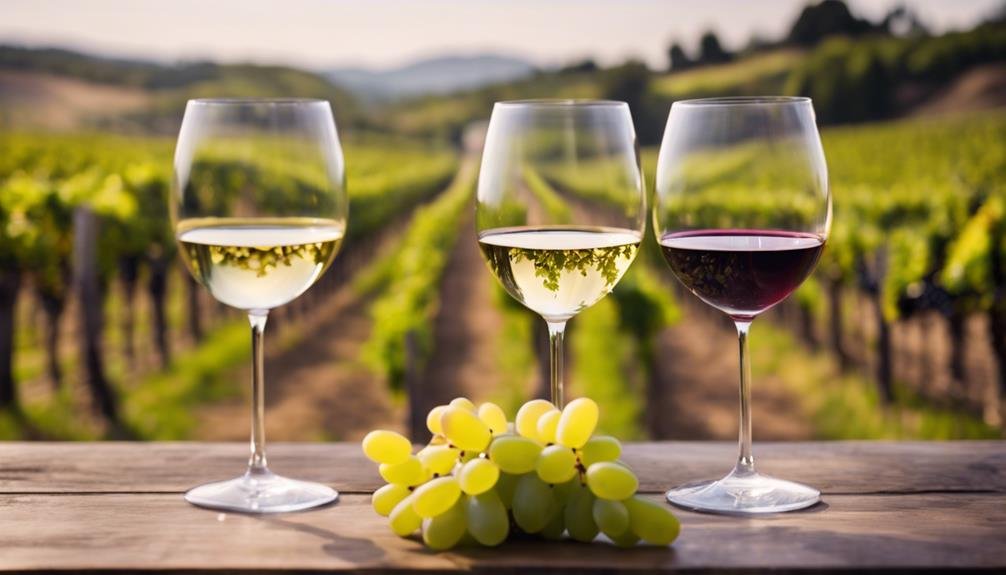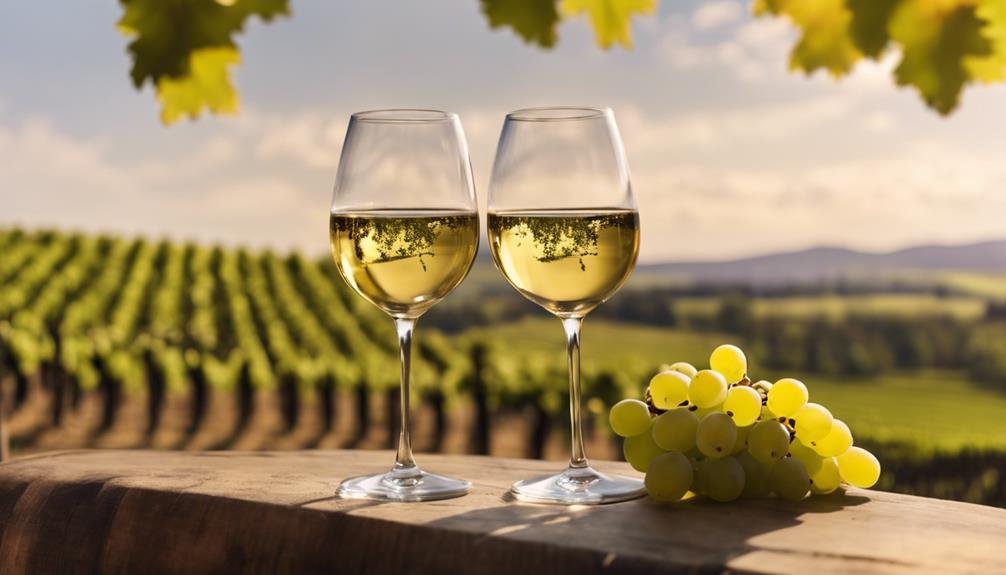In the world of wine, Chardonnay and Sauvignon Blanc engage in a delightful battle of flavors. Originating from Burgundy, France, Chardonnay boasts a larger global acreage compared to Sauvignon Blanc. Chardonnay's apple and yellow melon notes contradict Sauvignon Blanc's green, grassy aromas. Chardonnay favors warmer climates for ripeness, while Sauvignon Blanc thrives in cooler settings, preserving acidity. Chardonnay, often oak-aged for creamy hints, pairs well with delicate dishes, while Sauvignon Blanc's crispness complements high-intensity flavors. Distinctive regions and pricing differences exist between the two. The clash of these wines promises a taste exploration worth savoring further.
Origins and World Acreage Comparison
Comparing the origins and world acreage of Chardonnay and Sauvignon Blanc reveals interesting insights into the production and popularity of these two renowned white wines.
In vineyard exploration, Chardonnay originated in Burgundy, France, while Sauvignon Blanc hails from Bordeaux and Loire, France. Chardonnay boasts a larger world acreage of 491,000 compared to Sauvignon Blanc's 272,000 as of 2010.
When engaging in a comparative tasting, Chardonnay is often grown alongside Pinot Noir, while Sauvignon Blanc thrives with Merlot and Cabernet Sauvignon. Understanding these differences in origin and acreage can provide valuable context for appreciating the distinct characteristics and flavors of Chardonnay and Sauvignon Blanc.
Taste Profiles and Varietal Characteristics
When examining the taste profiles and varietal characteristics of Chardonnay and Sauvignon Blanc, one can discern distinct attributes that set these white wines apart.
| Chardonnay | Sauvignon Blanc |
|---|---|
| Flavor comparison: | Aroma notes: |
| – Apple, yellow melon, starfruit | – Green notes like fresh cut grass, gooseberry |
| Climate influence: | Climate influence: |
| – Thrives in warmer climates, leading to riper fruit flavors | – Flourishes in cooler climates, retaining acidity and herbal notes |
| Aging differences: | Aging differences: |
| – Often aged in oak barrels, resulting in creamy, buttery notes | – Minimal oak aging, preserving crisp, fruity characteristics |
Understanding these distinctions can guide wine enthusiasts in selecting the perfect white wine to suit their preferences.
Food Pairing Recommendations for Each

To further enhance the enjoyment of Chardonnay and Sauvignon Blanc, it is essential to contemplate ideal food pairings that complement the distinct characteristics of each white wine.
When pairing Chardonnay, seek flavor contrasts to elevate the experience. This wine harmonizes well with creamy and delicate flavors, making it a perfect match for dishes like chicken, seafood, and quiche. For dairy-free options, consider almond milk or nut-based sauces to complement the wine's profile.
On the other hand, Sauvignon Blanc thrives on culinary matches that offer high intensity. This wine pairs excellently with dishes like fish tacos, Mediterranean cuisine, and Thai food. Classic pairings with Sauvignon Blanc include goat cheese and cilantro-infused dishes, showcasing its versatility with various cuisines.
Oak Aging Distinctions and Implications
Oak aging in white wines imparts distinctive flavors and textures that add complexity and depth to the overall taste profile. When comparing oak aging in Chardonnay and Sauvignon Blanc varietals, some key points to note include:
- Oak Aging Benefits:
- Chardonnay often benefits from oak aging, which can impart creamy, vanilla, and buttery flavors to the wine.
- Sauvignon Blanc varietals may also undergo oak aging, leading to a creamier mouthfeel and adding complexity to the typically light-bodied wine.
- The choice of oak barrels and duration of aging can greatly influence the final flavor profiles of both wines.
These distinctions in oak aging practices contribute to the unique characteristics and flavor profiles of Chardonnay and Sauvignon Blanc wines, showcasing the impact of oak on these popular white varietals.
Notable Regions and Price Ranges

Among the factors influencing consumer choices in the white wine market, the notable regions and price ranges play a significant role in defining preferences and accessibility. When comparing Chardonnay and Sauvignon Blanc, understanding the price differences and regions known for value becomes essential. Below is a table outlining the price comparisons and value regions for these two popular white wines:
| Chardonnay | Sauvignon Blanc | |
|---|---|---|
| Price Range | $15–$20 | $10–$14 |
| Value Regions | Spain, Chile, Italy, Australia, Languedoc | Chile, Pays d'Oc, Friuli Venezia-Giulia |
These price ranges and value regions provide insight into the affordability and quality of Chardonnay and Sauvignon Blanc, influenced by regional flavors and production costs.
Frequently Asked Questions
Can Chardonnay Be Aged Like Red Wines?
Chardonnay, a white wine, can indeed be aged like red wines. Its aging potential reveals a remarkable transformation, enhancing its complexity, depth, and flavor profile. Aging benefits include developing rich textures and nuanced flavors.
Are There Any Vegan Food Pairing Options for Sauvignon Blanc?
For Sauvignon Blanc, vegan food pairing options include pairing with vegan cheese or plant-based appetizers. The wine's high intensity and versatile nature make it suitable for a wide range of vegan dishes, enhancing the dining experience for plant-based enthusiasts.
What Is the Impact of Climate on the Taste of Chardonnay?
Climate greatly influences Chardonnay taste preferences, showcasing a spectrum from cool to warm regions. Cooler climates yield crisp, citrus-driven profiles, while warmer areas offer riper, tropical fruit notes. This diversity underlines the significant impact of climate on Chardonnay flavor profiles.
Are There Any Unique Health Benefits Associated With Sauvignon Blanc?
Sauvignon Blanc may provide health benefits due to its antioxidant properties, contributing to overall well-being. With moderate alcohol content, enjoying this wine in moderation can potentially offer a pleasant drinking experience while supporting health.
How Do the Acidity Levels Differ Between Chardonnay and Sauvignon Blanc?
When comparing Chardonnay and Sauvignon Blanc, acidity levels vary notably. Chardonnay tends to have a lower acidity, offering a smoother taste, while Sauvignon Blanc typically boasts higher acidity, delivering a crisp and invigorating flavor profile. Both wines pair well with a variety of foods and have aging potential.
Conclusion
To sum up, the debate between Chardonnay and Sauvignon Blanc is like a delicate dance between two graceful partners on the wine stage. Each varietal brings its own unique flavors and characteristics, offering a diverse range of options for wine enthusiasts.
Understanding the distinct profiles, food pairings, and regional differences can enhance the tasting experience and broaden one's appreciation for these popular white wines. So, whether you prefer the full-bodied richness of Chardonnay or the light, herbaceous notes of Sauvignon Blanc, there's a perfect match out there waiting for you.
